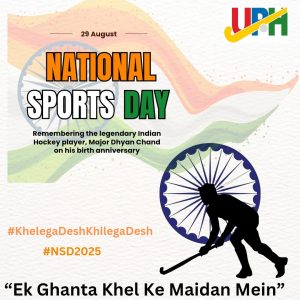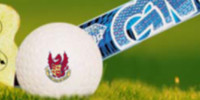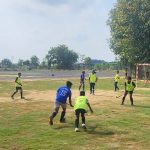UTTAR PRADESH HOCKEY
Welcome to Uttar Pradesh Hockey
(Affiliated to Hockey India, Uttar Pradesh Olympic Association & Directorate of Sports UP)
🏑 Welcome to Uttar Pradesh Hockey
Promoting Passion, Performance, and Pride in the Game of Hockey
Welcome to the official website of Uttar Pradesh Hockey – the governing body responsible for nurturing and promoting field hockey across the state. With a legacy of excellence and a vision for the future, we are committed to discovering young talent, developing world-class players, and strengthening hockey at the grassroots level.
From sub-junior to senior levels, our teams regularly participate and perform with distinction in Hockey India National Championships, Khelo India Youth Games, and National Games.
What We Do:
Conduct state championships and talent hunts
Organize training camps and coaching clinics
Select and field state teams for national-level tournaments
Work closely with districts and academies for hockey development
Our Vision:
To make Uttar Pradesh a powerhouse in Indian hockey by empowering our players, coaches, and officials with the right support, training, and opportunities.
“Ek Ghanta Khel Ke Maidan Mein”
(#KhelegaDeshKhilegaDesh #NSD2025)


Hockey became popular in India when the British Regiments played the game in India and introduced it in the British Indian Regiments who quickly picked up the game. The first hockey club was formed in Calcutta in 1885-86 followed by Bombay and Punjab.
Basic Field Hockey Rules
1. You may only use the flat side of your stick.
2. You must be properly attired – shin guards, mouth guards, no jewelry, etc.
3. 10 field players plus a goalie play at one time.
4. The field hockey game lasts for two 30 minute halves.
5. Substitutions – the field player must exit the field at the 50, only then can the new player step onto the field.
6. The ball cannot go in the air, especially on free hits. This is judged by the discretion of the ref. The exception is a shot on goal, as long as there is not a player in the direct line of the ball and no one is in harm’s way.
7. Self –start. When taking a hit into the circle, whether it is a free hit or long hit, you cannot directly hit into the circle. You must pass it first or carry the ball for 5 yards before hitting the ball into the circle.
For free hits anywhere else on the field, you may either: take a direct hit, pass to one of your players, or carry the ball for 3 yards before hitting it.
8. Any time a foul occurs in either team’s circle, a corner hit will be called.
Fouls
1. The ball cannot hit your feet.
2. You cannot raise your stick above your waste during regular play. If you are taking a free hit, it is up to the discretion of the ref.
3. You cannot tackle (go for the ball) from behind. You must face your opponent head on (shoulder to shoulder) if you are fighting for the ball.
4. No third party. It is one vs. one at all times. Once another player tries to go for the ball, a foul is called.
5. Obstruction – when your back is turned to another player and you are between the ball and that player.
Concepts of Hockey
Field hockey is a team sport of the hockey family. Each team plays with ten field players and a goalkeeper, and must carry a round, hard, plastic hockey ball with a hockey stick to the rival goal.
The game is played globally, particularly in parts of Western Europe, South Asia, Southern Africa, Australia, New Zealand, Argentina, and parts of the United States, primarily New England and the Mid-Atlantic states.
Known simply as “hockey” in most territories, the term “field hockey” is used primarily in Canada and the United States where “hockey” more often refers to ice hockey. In Sweden, the term landhockey is used, and to some degree in Norway, where the game is governed by the Norges Bandyforbund.
During play, goal keepers are the only players allowed to touch the ball with any part of their body, while field players can only play the ball with the flat side of their stick. A player’s hand is considered part of the stick if holding the stick. If the ball is touched with the rounded part of the stick, it will result in a penalty. Goal keepers also cannot play the ball with the back of their stick.
The team that scores the most goals by the end of the match wins. If the score is tied at the end of the game, either a draw is declared or the game goes into extra time, or there is a penalty shoot-out, depending on the format of the competition. There are many variations to overtime play that depend on the league or tournament rules. In American college play, a seven-aside overtime period consists of a 10-minute golden goal period with seven players for each team. If a tie still remains, the game enters a one-on-one competition where each team chooses five players to dribble from the 25-yard (23 m) line down to the circle against the opposing goalie. The player has eight seconds to score against the goalie while keeping the ball in bounds. The game ends after a goal is scored, the ball goes out of bounds, a foul is committed (ending in either a penalty stroke or flick or the end of the one-on-one) or time expires. If the tie still persists, more rounds are played until one team has scored. The game can be played on grass, watered turf, artificial turf or synthetic field, as well as an indoor boarded surface.
Hockey sticks are made of wood, carbon fibre, fibreglass, or a combination of carbon fibre and fibreglass in different quantities. The length of the hockey stick is based on the player’s individual height: the top of the stick usually comes to the players hip, and taller players typically have longer sticks. The sticks have a round side and a flat side, and only the flat face of the stick is allowed to be used. Use of the other side results in a foul. Goalies often have a different design of stick, although they can also use an ordinary field hockey stick. The specific goal-keeping sticks have another curve at the end of the stick, which is to give it more surface area to block the ball. The uniform consists of shin guards, shoes, shorts or a skirt, a mouthguard and a jersey.
The governing body of field hockey is the International Hockey Federation (FIH), called the Fédération Internationale de Hockey in French, with men and women being represented internationally in competitions including the Olympic Games, World Cup, World League, Champions Trophy and Junior World Cup, with many countries running extensive junior, senior, and masters club competitions. The FIH is also responsible for organizing the Hockey Rules Board and developing the rules of the game.
A popular variant of field hockey is indoor field hockey, which differs in a number of respects while embodying the primary principles of hockey. Indoor hockey is a 5-a-side variant, using a field which is reduced to approximately 40 m × 20 m (131 ft × 66 ft). Although many of the rules remain the same, including obstruction and feet, there are several key variations: players may not raise the ball unless shooting at goal, players may not hit the ball, instead using pushes to transfer it, and the sidelines are replaced with solid barriers, from which the ball will rebound and remain in play.[6] In addition, the regulation guidelines for the indoor field hockey stick require a slightly thinner, lighter stick than an outdoor one.
Field Measurements
HOCKEY GOAL DIMENSIONS
The crossbar of a field hockey goal should be 2.14m above the ground, measured from the bottom of the crossbar. The inner edges of the upright goalposts must be 3.66m apart. This gives the goal entrance a total area of 7.83sqm. Field hockey goals must also be at least 1.2m deep at ground level and at least 0.9m deep at crossbar level.
Hockey goals are made of two upright posts, joined at the top by a horizontal crossbar, with a net positioned to catch the ball when it passes through the goalposts. The goalposts and crossbar must be white and rectangular in shape, and should be 2in (50mm) wide and 2-3in (75 mm) deep.
Professional hockey goals also include sideboards and a backboard, which stand 46cm (1ft 6in) from the ground. The backboard runs the full 3.66m width of the goal, while the sideboards are 1.2m deep.
Regulation goal dimensions diagram for professional field hockey
Dimensions of a Hockey Net
Hockey nets can come in different dimensions depending on how deep at ground level and at crossbar level the goal is. Typical dimensions for a standard field hockey net are around 3.7m (W) x 2.1m (H) x 1.2m (D).
How Wide is a Hockey Goal?
The International Hockey Federation states that field hockey goals must be 3.66m (12ft) wide, with the goalposts themselves not more than 50mm (2in) wide.
Field Hockey Goal Dimensions in Feet
Regulation goal dimensions diagram in feet for professional field hockey
Field hockey goal dimensions in feet are as follows:
Width between goalposts: 12 feet
Distance from ground to bottom of crossbar: 7 feet
Depth at ground level: minimum 4 feet
Depth at crossbar level: minimum 3 feet
HOCKEY FIELD DIMENSIONS
Diagram of standard measurements for a field hockey pitch labelled for grass and turf
Hockey pitches are rectangular, with the longer edges (sidelines) measuring 91.4m long (100yd) and the shorter edges (backlines) measuring 55m wide (60yd). The total area of a standard field hockey pitch is 5,027sqm, which is 1.24 acres.
There must be at least 2m of run-off on either side of the field, and at least 3m of run-off at the backlines. The International Hockey Federation states that the last metre of run-off behind the backlines can be a different colour to the rest of the pitch if playing on artificial turf.
How big is a field hockey circle?
The striking circle, or penalty circle, in field hockey has a radius of 15m (16yd) and is actually a straight line with two quadrant arcs drawn at either side, to form a ‘D’ shape against the backline.
A straight line measuring 3.66m (4yd) – the same width as the goalposts – is positioned parallel to the goal, 14.63m (16yd) into the pitch. Two arcs, each with a radius of 14.63m, connect the ends of this line to the backline of the hockey field.
Hockey Field Dimensions in Feet
Diagram of standard measurements in feet for a field hockey pitch labelled for grass and turf
Hockey field dimensions in feet are as follows:
Length of sidelines: 300 feet
Width of backlines: 180.5 feet
Run-off at sidelines: minimum 6.5 feet
Run-off at backlines: minimum 9.8 feet
FIELD HOCKEY LINES
There are three main lines drawn across a field hockey pitch, spaced 22.85m (25yd) apart along the 91.4m (100yd) sidelines, reaching from side-to-side. The line in the centre of the field is called the half-way line, or centre line, and the two on either side are the 25 yard lines or 23 metre lines.
In addition to these three lines and the lines that make up the two striking circles, there are also a number of other markings on the field. From the centre of the backline, there are markers at 5m and 10m in either direction. These are the Penalty Corner Defender’s and Attacker’s marks. 10m is the mark from which an attacking team takes the penalty, and 5m is the mark for the closest position in which a defender may stand.
On each sideline there is also a mark 5m from the backline, which is the Long Corner Attacker’s mark.
What is the dotted line in field hockey?
The dotted line in field hockey sits 5m outside the striking circle, and if a ball travels past the dotted line during a penalty corner, that penalty corner is now over. On pitches with no dotted line, the penalty corner is still over if the ball travels more than 5m outside of the striking circle.
The dotted line used to dictate the point where free hits must be taken from in the event of a foul within the ‘D’. That rule was removed in 2015 and many pitches no longer feature the dotted line, as it is no longer an international requirement.
What is a 16 yard hit in field hockey?
In field hockey, a 16 yard hit is a free hit for the defending team after an opposition player commits a foul within the striking circle or hits the ball over the backline. It is taken 16yd (14.63m) from the backline.
Why Are Hockey Pitches Wet?
Hockey pitches are wet because water helps to reduce friction on the surface of the pitch, which allows the hockey ball to travel more smoothly. Water also helps to stop the ball bouncing, which can be dangerous for the hockey players, and reduces friction burns from artificial turf when players fall.
Why Are Hockey Pitches Blue?
Diagram of field hockey lines for indoor and outdoor courts and circles
The London 2012 Olympics started a new trend for blue hockey pitches, because blue turf helps television viewers to clearly see the ball and markings on the hockey pitch during gameplay. Not all hockey pitches have to be blue, but a yellow ball on blue turf is now the standard for professional field hockey tournaments.

I am text block. Click edit button to change this text. Lorem ipsum dolor sit amet, consectetur adipiscing elit. Ut elit tellus, luctus nec ullamcorper mattis, pulvinar dapibus leo.
Uttar Pradesh Hockey Celebrates Olympic Day 2025 Across All Districts
Uttar Pradesh Hockey proudly announces the successful celebration of Olympic Day 2025 across all its district units.
In true Olympic spirit, players, coaches, and hockey enthusiasts from every corner of the state came together to honor the values of excellence, friendship, and respect. The day was marked by various activities including fitness runs, awareness campaigns, hockey matches, and motivational sessions to spread the message of unity through sports.
This collective celebration reinforces our commitment to promoting the Olympic ideals and nurturing hockey talent at the grassroots level. Uttar Pradesh Hockey remains dedicated to inspiring the youth and building a strong future for Indian hockey.
Happy Olympic Day 2025!
— Uttar Pradesh Hockey
#uttarpradeshhockey #hockeyindia #uphockey
https://www.instagram.com/reel/DLP3OXbyBQj/?igsh=aG54eXRrbXI4bXF1



























